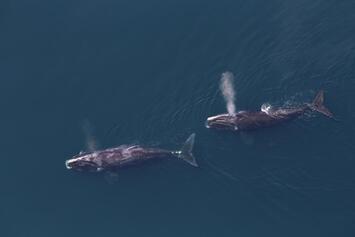
Environmentalism in America is dead. It has been replaced by climatism and renewable energy fetishism.
The movement birthed by Rachel Carson’s Silent Spring in the early 1960s and Earth Day in the 1970s — a movement that once aimed to protect landscapes, wildlands, whales, and wildlife — has morphed into the NGO-corporate-industrial-climate complex. Rather than preserve wildlands and wildlife, today’s “green” NGOs have devolved into a sprawling network of nonprofit and for-profit groups aligned with big corporations, big banks, and big law firms. In the name of climate change, these NGOs want to pave vast swaths of America’s countryside with oceans of solar panels and forests of 600-foot-high wind turbines. They are also promoting the industrialization of our oceans, a move that could put hundreds of massive offshore wind turbines in the middle of some of our best fisheries and right atop known habitat of the critically endangered North Atlantic Right Whale.
The simplest way to understand how climatism and renewable energy fetishism have swamped concerns about conservation and wildlife protection is to follow the money. Over the past decade or so, the business of climate activism has become just that — a business. As I reported last year in “The Anti-Industry Industry,” the top 25 climate nonprofits are spending some $4.5 billion per year. As seen below, the gross receipts of the top 25 climate-focused NGOs now total about $4.7 billion per year.

These groups — which are uniformly opposed to both nuclear energy and hydrocarbons — have budgets that dwarf those of pro-nuclear and pro-hydrocarbon outfits like the Nuclear Energy Institute, which, according to the latest figures from Guidestar, has gross receipts of $194 million, and the American Petroleum Institute which has gross receipts of $254 million. (Unless otherwise noted, the NGO figures are from Guidestar, which defines gross receipts as a “gross figure that does not subtract rental expenses, costs, sales expenses, direct expenses, and costs of goods sold.” Also note that in many cases, Guidestar’s gross receipts figure doesn’t match the revenue that the NGOs are reporting on their Form 990s.)
To understand the staggering amount of money being spent by the NGO-corporate-industrial-climate complex, look at the Rocky Mountain Institute, the Colorado-based group founded by Amory Lovins, the college dropout who, for nearly 50 years, has been the leading cheerleader for the “soft” energy path of wind, solar, biofuels, and energy efficiency. (Click here for my 2007 article on Lovins.) Between 2012 and 2022, according to ProPublica, Rocky Mountain Institute’s annual budget skyrocketed, going from $10 million to $117 million.
Read the rest of this piece at Robert Bryce Substack.
Robert Bryce is a Texas-based author, journalist, film producer, and podcaster. His articles have appeared in a myriad of publications including the Wall Street Journal, New York Times, Forbes, Time, Austin Chronicle, and Sydney Morning Herald.
Photo: Two North Atlantic Right Whales photographed in 2016 by Tim Cole, NOAA Fisheries.












